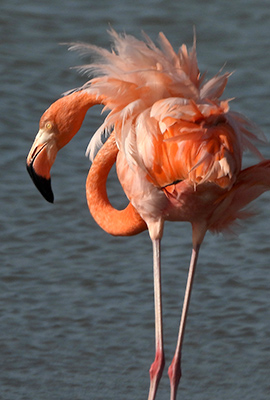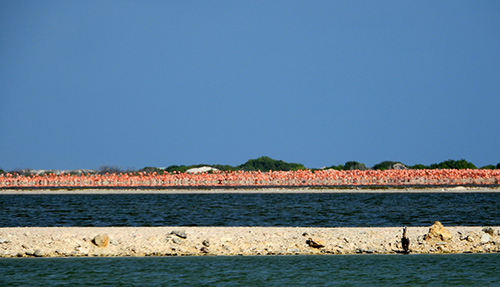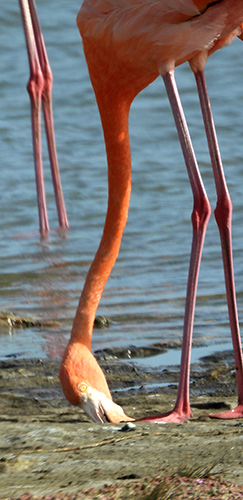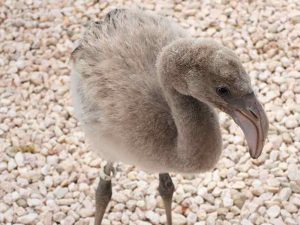Bonaire’s Flamingo is the Island’s Icon.
The American Flamingo
Posted September 8, 2019
Everything you’d like to know about the iconic Bonaire flamingo.
About Bonaire’s flamingo, the American Flamingo.
The American Flamingo (Phoenicopterus ruber), also known as the Caribbean Flamingo, is the only flamingo that naturally inhabits North America. It is closely related to the Greater Flamingo and Chilean Flamingo. Bonaire is one of only four locations where the American Flamingo breeds. It is such an icon of Bonaire, that the island’s airport is named after it: Flamingo Airport, and, of course, the airport is pink!
Flamingos can be found at many locations around Bonaire, but dense concentrations occur at Pekelmeer in the south of Bonaire, Lac Bay, and also at Gotomeer, in the north of Bonaire. There are also flamingos to be found in Washington-Slagbaai National Park, usually at Boka Slagbaai, although they could be observed at other saliñas in the park as well.
Adult American Flamingos are the largest flamingos in the Americas. They measure from 120 to 145 cm (47 to 57 inches) tall. The males weigh an average of 2.8 kg (6.2 lb), while females average 2.2 kg (4.9 lb). Its life expectancy is 40 years. Most of its adult plumage is pink to coral-colored (the exact color will depend upon the food they consume), while the primary and secondary flight feathers are black. The bill is pink and white with an extensive black tip. The legs are entirely pink. The call is a goose-like honking.
Vocalization of the American Flamingo.
Monthly population checks are conducted.
Because Bonaire’s flamingo is important to its nature, the island conducts monthly population checks. In days past, one would be able to say that there were more flamingos than people on the island, but, while the flamingo population has remained stable, the human population has grown in the past decade.
The courtship rituals and breeding habits of the American Flamingo.
Flamingos on Bonaire may breed up to three times a year. However, the main breeding time is March through mid-July.
As early as December, one might begin to observe courtship displays: the raising of wings, or lifting of the heads with a side-to-side motion. There’s an elaborate dance.
By January, the breeding colony is forming deep in Pekelmeer. One might see a thin line of pink on the horizon, as thousands of birds congregate.
After a mate is chosen, the pair will build a nest out of mud, looking somewhat like a tower, and which can reach a diameter of 40 cm (16 inches). There’s just enough space in between nests to ensure a little privacy–and no pecks from nearby flamingos.
After mating, the female usually will lay one egg. Both parents incubate the egg for about four weeks. After hatching, the chick, which is born a white-gray color, will remain in the nest for six to eight days. After this time, it is able to leave the nest and join other juveniles in the “flamingo daycare,” large gatherings of chicks with adult supervision.
At this stage of their development, the chicks are able to run and swim, but they cannot yet fly. The parents will feed them via regurgitation.
Feeding habits of the American Flamingo.
Filter-feeding.
Bonaire’s flamingos use their feet to stir up the mud. They then invert their head upside down (their bill is perfectly shaped for this), and they take in water through their bills. The flamingos then use the sieve-like strainers on the bills, filtering out the water, while keeping in small brine shrimp, seeds, algae, mollusks, and other microscopic organisms.
“Hoovering.”
One might also observe the flamingo feeding in another way, called by locals, “hoovering” (as in the manufacturer of vacuum cleaners). In this method, the flamingo will walk along the shoreline, and its head will sweep back and forth as it vacuums in and enjoys a tasty meal of brine flies.
Visits to nearby Venezuela.
Although Bonaire is the perfect spot for the breeding of the American Flamingo, nearby Venezuela actually provides a better location for feeding. One can observe small groups of flamingos heading out to sea about sunset, as they fly to the Venezuelan coastline to feed. Once sated, they head back to Bonaire and can be seen arriving about sunrise.
Is there enough food for the flamingo chicks?
In 2018 and 2019 it was estimated that about 1000 flamingo chicks were born on Bonaire each year. It’s natural that some will not be strong and will not make it to adulthood. However, in these years, an extraordinary amount of Bonaire’s flamingo chicks were found out of the breeding colony. During periods of heavy wind, they might be blown out of the protected area, but it was found that many of these chicks were also underweight and malnourished.
Bonaire Wild Bird Rehab
To try to assist Bonaire’s flamingo chicks which were experiencing a problem, Elly Albers, who has helped Bonaire’s birds in need for many years, created the Bonaire Wild Bird Rehab foundation. In 2019, she took in over 450 flamingo chicks, many of which she rehabilitated and returned to their natural habitat. Research also was conducted this year to see if there was food at the breeding colony’s site, and it was found that there was indeed food. What is not known yet is if there is enough food.
Why is there a potential lack of food?
Although there are many with theories as to why the birds do not appear to be finding sufficient food, thus causing their underweight and malnourished state, the truth is that no one knows for sure. Until there is additional research done, Bonaire Wild Bird Rehab will continue to do their utmost to help Bonaire’s flamingo chicks.
Banded flamingos.
In 2019, Bonaire Wild Bird Rehab received permission from The Netherlands to band the birds which come into the rehabilitation center. By doing so, each bird can be tracked, and, should it be returned another day, the center will know exactly what the bird’s prior situation was. If you see Bonaire’s flamingos with leg bands, numbered or color-coded, do not worry. You are simply observing one of the center’s success stories.
If you find a flamingo in need of assistance, please use the following contacts to get help.
Contact the following for assistance (in the order provided) should you find one of Bonaire’s flamingos in need, or really any wild bird which is injured or needs help.
- F.K.K. Animal Rescue: +599 780-8020
- Dierenbescherming Bonaire (Animal Welfare): +599 796-7000
- Bonaire Wild Bird Rehab: +599 780-5353
Photo tips for better flamingo images.

1. Keep your distance!
2. Use your vehicle as a blind.
3. Shoot during the golden hour.
Quick facts and current status of the American Flamingo.
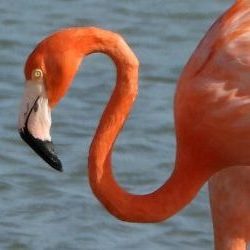
American Flamingo
(Phoenicopterus ruber)
Diet: Small shrimp, seeds, blue-green algae, microscopic organisms, and mollusks
Breeding: Lays 1 egg
Status: Least Concern
About the author
Susan has been living on Bonaire for over 30 years. She is a certified bird guide, a PADI SCUBA Diving Master Instructor, and an underwater and topside photographer.
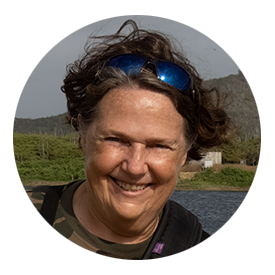
Get in touch with Susan
Contact Susan via email, Facebook Messenger, call Susan or use the online form below.
If you have any questions about your Bonaire birding tour, feel free to contact Susan for answers. She is always willing to go into more detail about routes or the best times for a tour based on your personal preferences. Tours can be tailored to your interests, whether that be birds, photography, or both!
It is also a good idea to do some homework on the birds of Bonaire before you come. Knowing a little about the birds you might encounter on your tour will make your experience even more enjoyable!
Be sure to check out these resources for birding on Bonaire. Also, reading the Bird Blog will introduce you to the birds that might be observed on Bonaire.
Get In Touch
Get in touch with Susan to check availability for the dates you are visiting Bonaire.
Consent: By using this form you agree with the storage and handling of your data by this website.

